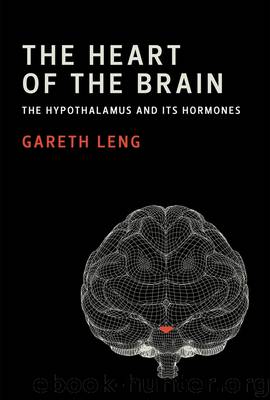The Heart of the Brain by Leng Gareth;

Author:Leng, Gareth;
Language: eng
Format: epub
Tags: neuroscience; neurobiology; neurons; neuroneshypothalamus; hormones; peptides; endocrinology; neuroendocrinology; pituitary; oxytocin; vasopressin; appetite; obesity; love; maternal behavior; maternal behaviour;bonding; social behavior; social behaviour; evolution of the brain; optogenetics; lactation; prolactin; growth hormone; kisspeptin; reproduction; ovulation; estrogen; oestrogenstress; adrenal glandrhythms; pulsatilityphysiology; leptin; brain
Publisher: MIT Press
14 Plasticity
Whether ’tis nobler in the mind to suffer
The slings and arrows of outrageous fortune,
Or to take Arms against a Sea of troubles,
And by opposing end them:
—William Shakespeare, Hamlet
About twenty years ago I was invited to be an instructor at a training school for new researchers in endocrinology. The school was funded by the pharmaceutical company Ferring, and was held on the island of Föhr in the North Sea, at the home of Fredrik Paulsen, the founder of Ferring. The high points of the week, for me, were two after-dinner talks given by Fredrik, one on the history of Ferring, and another on language. Föhr is a small island with just a few thousand inhabitants, but seven languages are spoken there, including one, Fering, which is spoken only on Föhr. Fredrik’s theme was that every language is a unique repository of knowledge and understanding.
Föhr had been a whaling community, and in the early race to develop treatments for the diseases of hormone deficiency, whales played a small but important part. As might be expected, the pituitary of the whale is large and a rich source of hormones very like those of humans. Moreover, the anterior pituitary is separated from the posterior pituitary by a bony plate, making it easy to separate the tissues without cross-contamination, so Fredrik recruited whalers to salvage the pituitaries for research. In Fering, the pituitary is known by an idiom that translates as “the button on the brain.” Whalers had long recognized this conspicuous gland and had noticed that, when a whale had fought particularly long and hard, the pituitary would be engorged with blood. This explains another idiom—“the button on his brain has burst,” applied to someone overcome by stress. Fredrik argued that knowledge of the pituitary’s involvement in stress was embedded in the language, long predating our scientific awareness.
Anyone who attempts to track the historical development of physiological concepts is likely to become frustrated at their imprecision and instability. Terms that appear to define specific biological entities, like genes, neurotransmitters, and hormones, have accrued multiple different and sometimes incompatible meanings that depend on the context in which they are used. Today, in some contexts, a gene is the sequence of DNA that encodes a specific protein; in others, it is the longer unit that spans the exons that encode the protein sequence but also includes the introns that separate the exons and which themselves include sites that regulate the expression of the gene product; in yet others, it is a longer and ill-defined sequence that includes all regulatory sites. Sometimes, such as when we talk of the gene for a certain trait that differs between individuals, we mean a variant version of some site of regulation of a gene. Sometimes we talk loosely about genes as though they were synonymous with specific traits, as in the “genes for hair color.” Sometimes, even more loosely, we talk of genes “for” diseases like cystic fibrosis or Huntington’s disease, as though their purpose is to give us these diseases.
Download
This site does not store any files on its server. We only index and link to content provided by other sites. Please contact the content providers to delete copyright contents if any and email us, we'll remove relevant links or contents immediately.
Sapiens: A Brief History of Humankind by Yuval Noah Harari(13941)
Sapiens by Yuval Noah Harari(5100)
Homo Deus: A Brief History of Tomorrow by Yuval Noah Harari(4662)
Pale Blue Dot by Carl Sagan(4590)
Livewired by David Eagleman(3520)
Origin Story: A Big History of Everything by David Christian(3457)
Brief Answers to the Big Questions by Stephen Hawking(3226)
Inferior by Angela Saini(3135)
Origin Story by David Christian(2973)
The Gene: An Intimate History by Siddhartha Mukherjee(2905)
Signature in the Cell: DNA and the Evidence for Intelligent Design by Stephen C. Meyer(2863)
The Evolution of Beauty by Richard O. Prum(2855)
Aliens by Jim Al-Khalili(2686)
How The Mind Works by Steven Pinker(2600)
A Short History of Nearly Everything by Bryson Bill(2494)
Sex at Dawn: The Prehistoric Origins of Modern Sexuality by Ryan Christopher(2399)
From Bacteria to Bach and Back by Daniel C. Dennett(2381)
Endless Forms Most Beautiful by Sean B. Carroll(2339)
Who We Are and How We Got Here by David Reich(2328)
